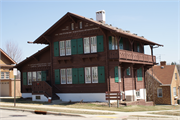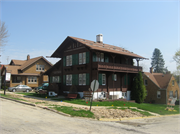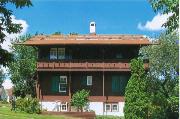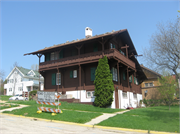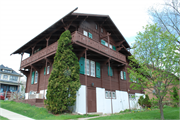Property Record
618 2ND ST
Architecture and History Inventory
| Historic Name: | Chalet of the Golden Fleece (Edwin Barlow, Fanny Figi House) |
|---|---|
| Other Name: | CHALET OF THE GOLDEN FLEECE |
| Contributing: | Yes |
| Reference Number: | 50756 |
| Location (Address): | 618 2ND ST |
|---|---|
| County: | Green |
| City: | New Glarus |
| Township/Village: | |
| Unincorporated Community: | |
| Town: | |
| Range: | |
| Direction: | |
| Section: | |
| Quarter Section: | |
| Quarter/Quarter Section: |
| Year Built: | 1938 |
|---|---|
| Additions: | |
| Survey Date: | 19762015 |
| Historic Use: | house |
| Architectural Style: | Other Vernacular |
| Structural System: | |
| Wall Material: | Wood |
| Architect: | J. Jacob Rieder |
| Other Buildings On Site: | |
| Demolished?: | No |
| Demolished Date: |
| National/State Register Listing Name: | Chalet of the Golden Fleece |
|---|---|
| National Register Listing Date: | 8/24/2015 |
| State Register Listing Date: | 2/27/2015 |
| National Register Multiple Property Name: | |
| National/State Register Listing Name: | 1st and 2nd Street Historic District |
| National Register Listing Date: | 5/10/2021 |
| State Register Listing Date: | 11/20/2020 |
| National Register Multiple Property Name: |
| Additional Information: | A 'site file' exists for this property. It contains additional information such as correspondence, newspaper clippings, or historical information. It is a public record and may be viewed in person at the State Historical Society, Division of Historic Preservation. Architect and builder Rieder constructed this house for Barlow, who initiated the annual “William Tell” play, a popular event in New Glarus. The Barlow House’s wooden Swiss chalet design is a relatively recent import to the town; the early Swiss settlers actually built their homes of limestone rubble in the traditional style of their homeland, the canton of Glarus. In contrast, Rieder’s design for the Barlow House is based on the traditional houses built by prosperous cattle growers in the canton of Bern. Characteristically, Bernese challis, or "Swiss chalets," were two-story wooden buildings sheltered by gabled roofs with deep overhangs. A traditional challis functioned much like a housebarn: the second story housed a cavernous hayloft, and the basement served as a creamery where the farmer made cheese and butter. Chalets are famous for their carved woodwork, which the Barlow House boasts in the arcade above its windows and in the scalloped pattern along its eaves. The balcony cantilevered to the side, with its pattern-pierced wooden balustrade and timber brackets, typifies the style, and this pierced woodwork is also present in the window boxes, stair railing, and shutters. German-language aphorisms adorn the exterior. The one painted above the door means, according to Barlow, "one brings nothing into the world and takes nothing out; he owns the house, but it must stay behind him and someone else will own it." To see an even more traditional example of a Bernese chalet, visit the Ernest Thierstein House, located at the southwest corner of Third Street and Twelfth Avenue. That house, which Jakob Rieder also created, features a jerkinhead or clipped-gable roof with arched bargeboards at the eaves, which overhang a front gallery. The creation of a self-consciously ethnic “Swisscape” to foster tourism came decades after Rieder created these replicas of traditional Bernese architecture, following the closing of a milk-condensing plant, then the town’s largest employer, in the 1960s. The home of Fanny Figi and her nephew Edwin Barlow, originator of the Wilhelm Tell drama, was designed by Swiss born architect, Jacob Rieder. It was later presented by Mr. Barlow to the village and opened as a museum in 1955. The home contains the rare articles collected by its former owners. 2006- "Typical Swiss mountain chalet has a gable roofed rectangular structure with broad eaves, a balcony, and decorative detail associated with Swiss design. The chalet served as the home of Edwin Barlow, originator of the Wilhelm Tell drama, and Fanny Figi, his aunt until 1955 when it was given to the Village to serve as a museum. It was designed and built by Jacob Rieder." -"Historic Landmarks of New Glarus", Historical Preservation Commission of New Glarus, prepared by Amanda Crary, 2006. |
|---|---|
| Bibliographic References: | (A) NEW GLARUS POST 2/1/1995. (B) INSCRIPTION. (C) NEW GLARUS POST 6/26/1996. (D) MUSEUM BROCHURE. (E) THE HISTORY OF THE NEW GLARUS HISTORICAL SOCIETY, INC. 1976. (F) Buildings of Wisconsin manuscript. A Walking tour of Historic New Glarus, Wisconsin, ca. 1995. |
| Wisconsin Architecture and History Inventory, State Historic Preservation Office, Wisconsin Historical Society, Madison, Wisconsin |

